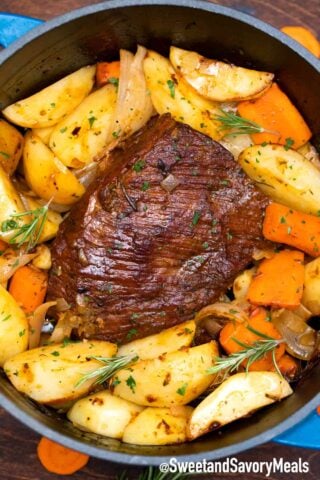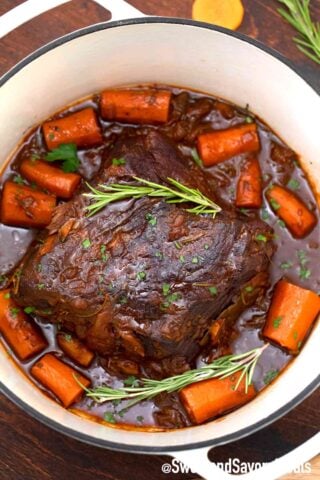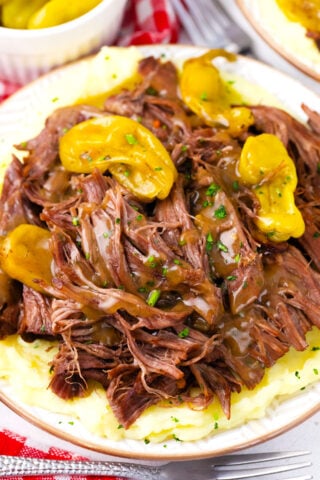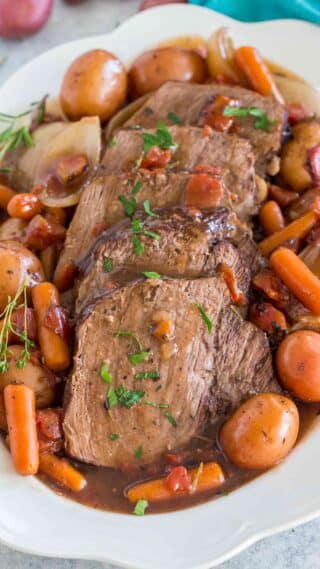Balsamic Pot Roast
Balsamic pot roast is one of my signature dishes for when I have company. The balsamic reduction is just fantastic drizzled over the tender and juicy meat. This recipe delivers rich and bold flavors. It tastes and looks impressive with minimal effort and 30 minutes of prep time; the oven does the rest.
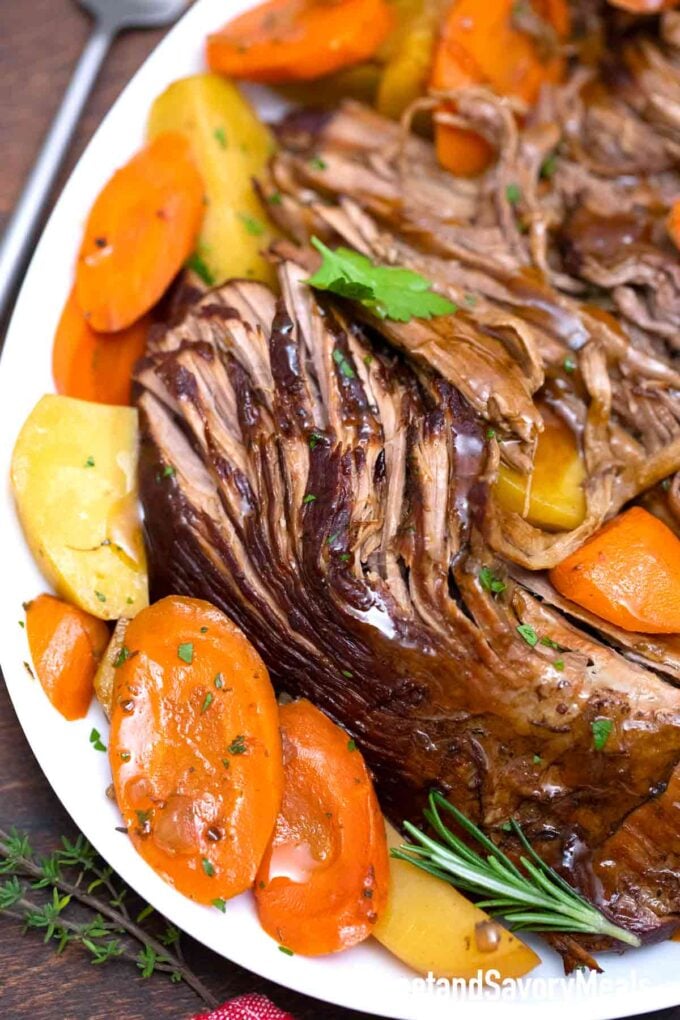
It may taste gourmet, but it’s also seriously easy to make. Just sear the roast, add the ingredients to a Dutch oven, and let the oven do the rest. This is the recipe to try if you are looking for a no-fuss, intensely flavorful, and satisfying meal. I have a few more up my sleeve; I highly recommend you also try my Guinness pot roast and incredibly delicious Mexican pot roast.
Table of contents
I like to make and share tried-and-true recipes that make cooking stress-free and enjoyable. A fancy meal does not have to be complicated; on the contrary, it can be simple and low-maintenance, like this balsamic pot roast. The balsamic vinegar’s deep and slightly tangy richness elevates this comforting meal, making it perfect for busy weeknights or special occasions.
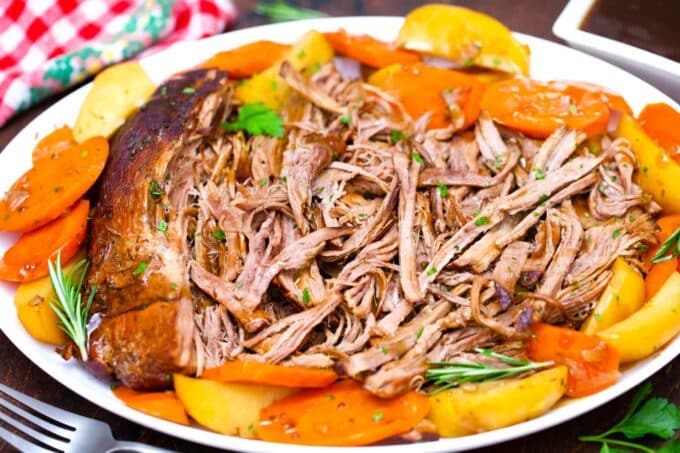
Why you will love this recipe
- It is so full of flavor: My rich and tangy pot roast is packed with flavor from being simmered in balsamic vinegar and various other herbs and spices, including my secret ingredient. With my unique blend of sauces and succulent aromatics, the beef is full of different tastes.
- No need for other dishes: I designed this recipe so that there is no need to make anything else. The side dishes are already included in the pot with the meat.
- Perfect for dinner or a dinner party: Since it is so easy to make but tastes so impressive, my balsamic pot roast is ideal for a weeknight dinner or a fancy dinner party. It only takes a few minutes to prepare, and then it takes care of itself.
- Clean-up is a breeze: Since it is all done in one pot, there are not a lot of dishes to clean either. So, whether made for a party or the family, it does not have to be a big chore.
What you will need
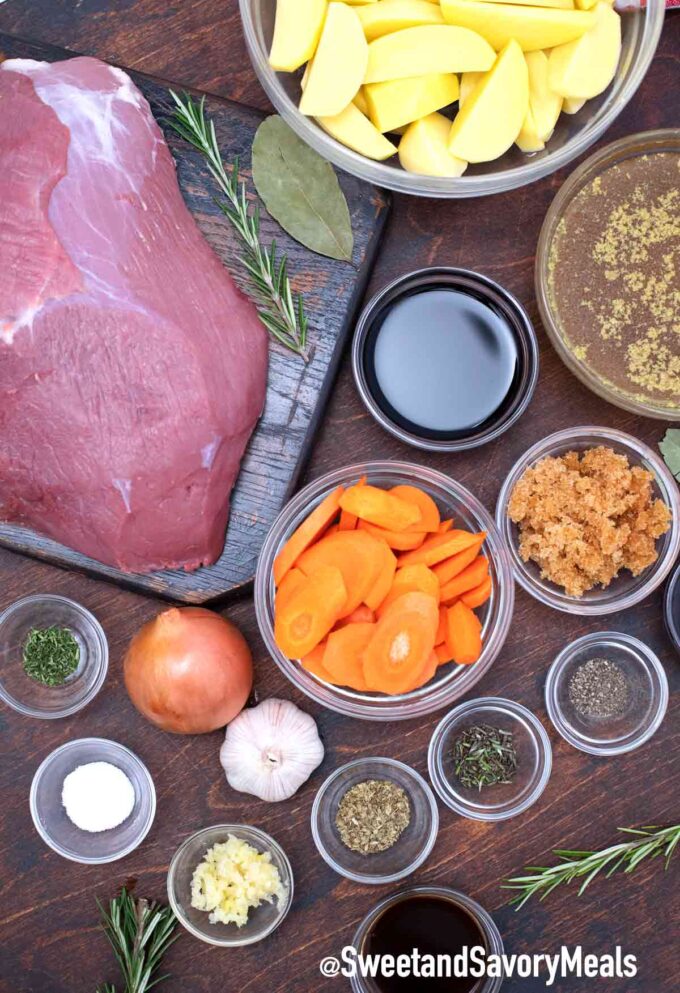
- The roast: I use a four-pound chuck roast because it is full of collagen, which breaks down and turns into delicious tenderized juicy meat.
- Veggies: My veggies are just carrots and potatoes, chopped into large chunks so they don’t get soggy. I prefer Yukon gold potatoes because they hold their shape better.
- Aromatics: Freshly minced garlic and chopped yellow onions are my aromatics of choice for this roast.
- Seasonings: Brown sugar, salt, and pepper are the main seasonings I use to add flavor to the roast and the broth.
- Liquids: Beef broth (low sodium) is the base for cooking this roast, but I also add Worcestershire sauce, molasses, and balsamic vinegar for extra flavor.
- Herbs: I also add a bit of thyme, oregano, rosemary, and bay leaves.
How to make
Sear the meat: First, pat the beef dry with paper towels and season it with salt and pepper. Then, I add two tablespoons of canola oil to the Dutch oven over high heat and wait for it to get hot. Once the oil is simmering, I sear the meat for about five minutes on each side until it is nicely browned.
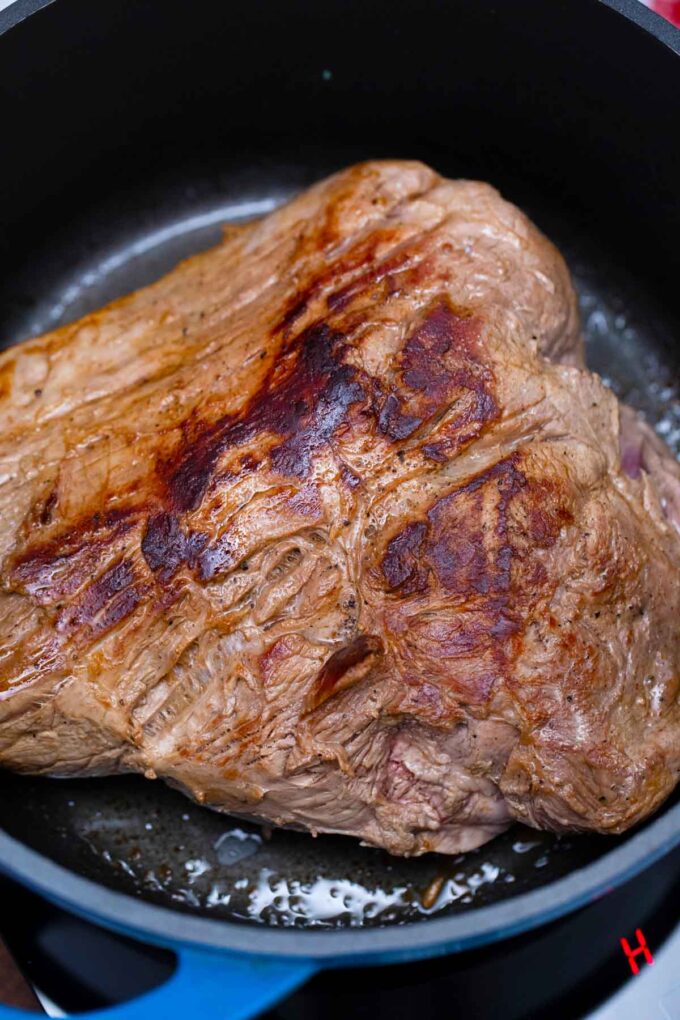
Saute the onion: I add the onion and cook for another two minutes before stirring in the garlic, oregano, rosemary, and thyme.
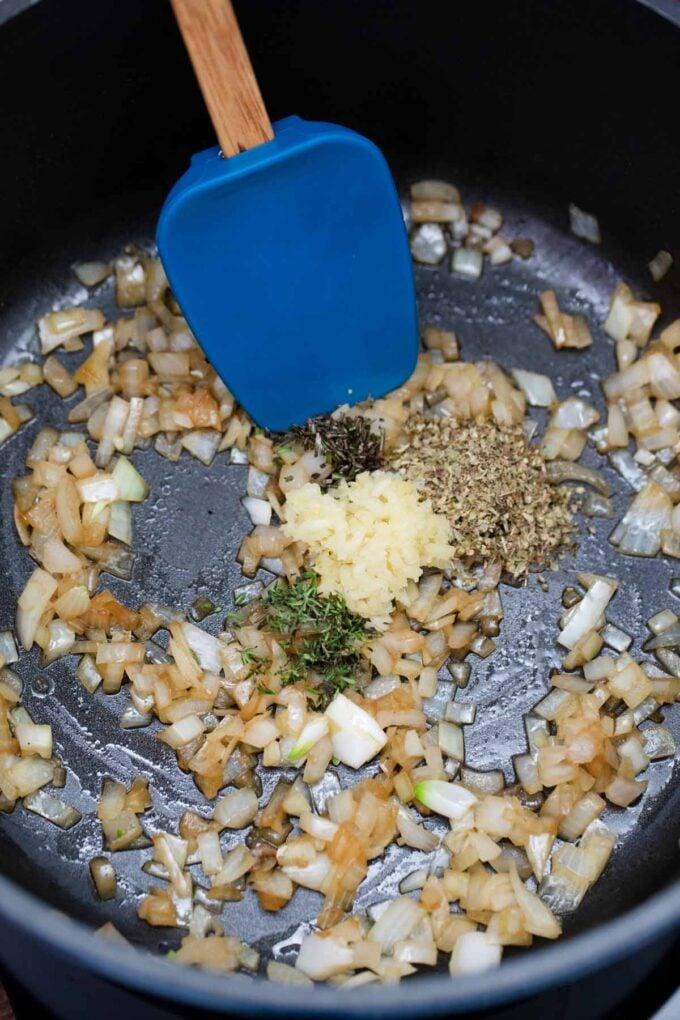
Saute the veggies: After that, I preheat the oven, add one cup of broth, and scrape the bottom of the pan well before pouring in the rest of the broth, Worcestershire sauce, balsamic vinegar, brown sugar, and molasses. I stir to combine and then put the beef back in with the potatoes, carrots, fresh rosemary, and bay leaves.
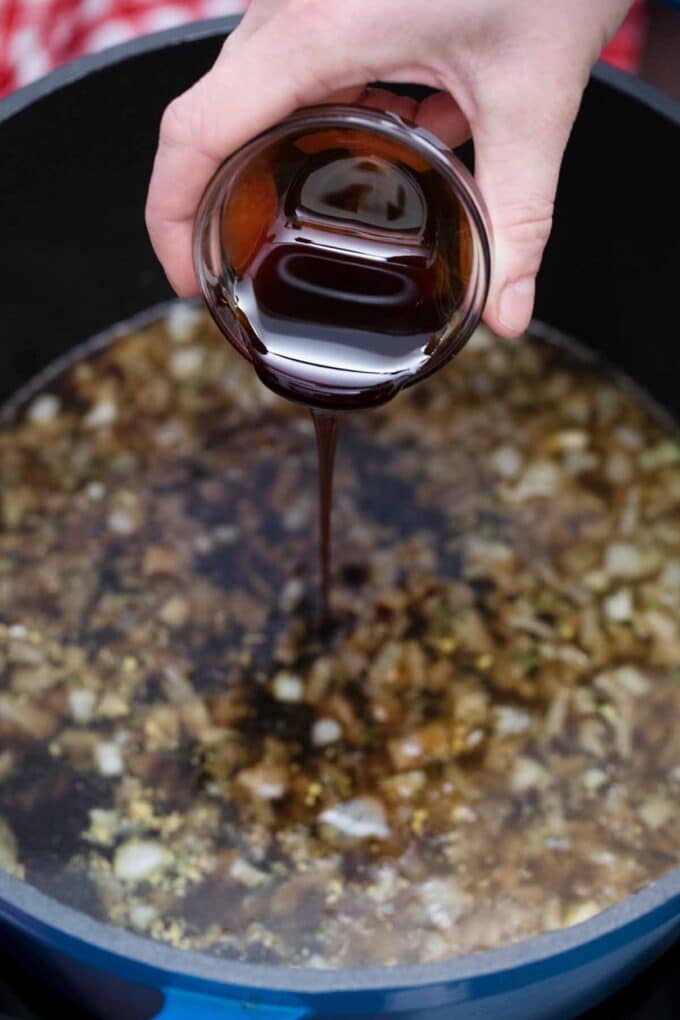
Bake the roast: I cover the pot and bake it for about three hours or until it reaches 135 degrees F with a meat thermometer. I discard the bay leaves and let the roast rest for 15 minutes before serving.
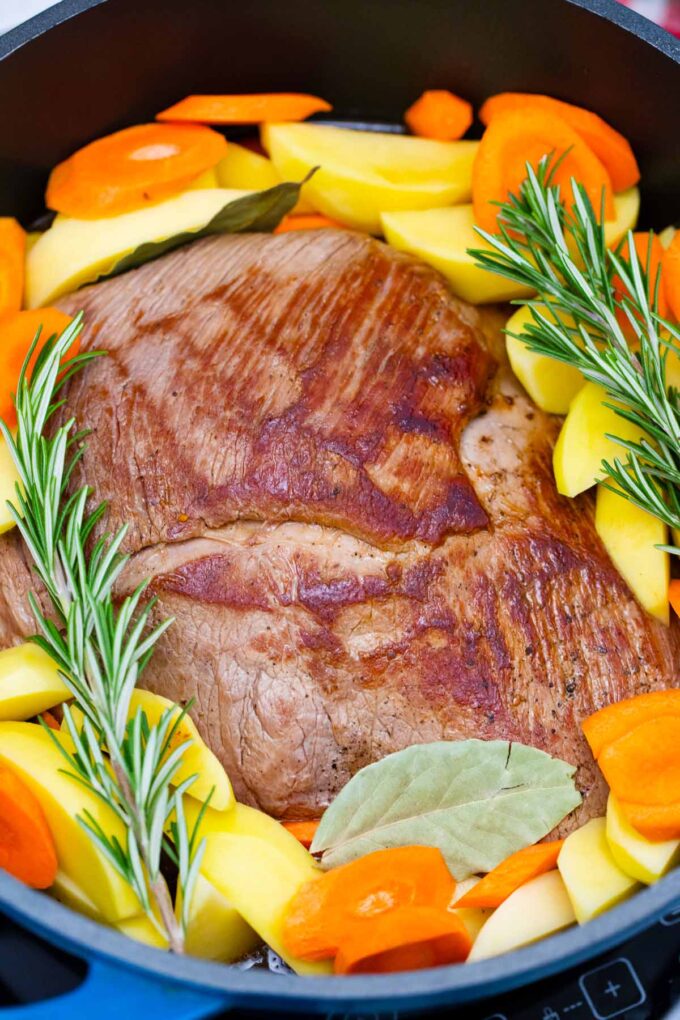
Make the glaze: To make the sauce into a glaze, I spoon off the fat and pour the liquid into a pot, cooking on medium for 10 minutes until it thickens.
Make it in the slow cooker
The slow cooker is an excellent alternative to the oven. I like that I don’t have to watch over it, and it doesn’t heat the kitchen as much. Follow the searing step and brown every side of the chuck. Then, add all the ingredients to the slow cooker. Cook for 4 hours (set on high) and up to 8 hours (set on low). Finally, make the reduction by straining the liquid and simmering it until it turns into a syrupy glaze.
Make it in the Instant Pot
Begin by browning the chuck nicely on all sides. Use the Sauté function for this. Deglaze the bottom of the pot, then pour in the rest of the braising liquid ingredients. Arrange the chuck at the bottom, topped with the veggies, bay leaves, and herbs. Set the IP to pressure cook for about 30 mins; finish with a natural release.
Remove everything, leaving only the liquid behind. Reduce until it turns into a thick glaze. Pour that over the meat or return the meat to the glaze to coat before serving.
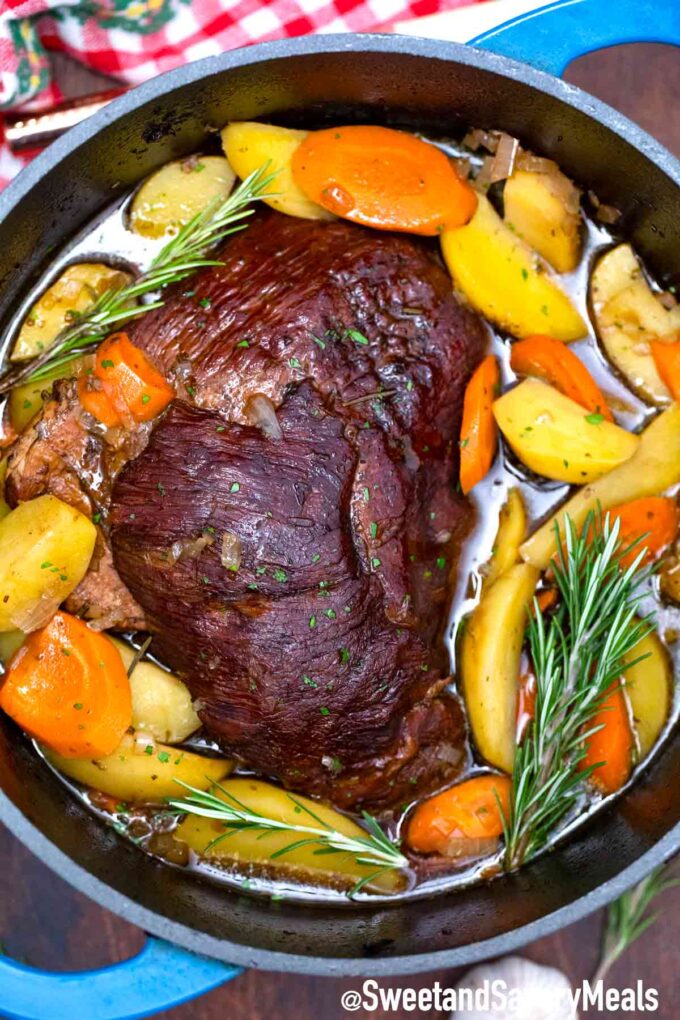
Expert tip
Adding extra layers of flavor when deglazing
Deglazing is one of the most important steps in roasting. Browning the beef brings out the flavors in the roast and loosens the browned bits from the bottom of the pan. When deglazing the pan, I prefer beef broth to water because it gives the roast more flavor. However, other ways add even more flavor to the meat. I have used other ingredients for deglazing, like my favorite wine, such as Pinot Noir or Cabernet Sauvignon. Red wine vinegar would be an excellent choice, giving a sweet and tangy taste.
Since this recipe uses balsamic vinegar, I like to keep the other flavors savory. For example, Worcestershire sauce or soy sauce would work with this sweet and tangy dish. I also like to use my favorite tomato sauce, made with San Marzano tomatoes combined with various herbs, to give it a multitude of flavors. Other things to try are apple cider, fruit juice, and beer.
More tips to consider:
- I use a meat thermometer to check the temperature to be sure when it is done cooking.
- I like to serve my roast at 145 degrees F, so I remove it from the oven when it is 135 degrees F. It will continue to cook as it rests.
- Be sure to get high-quality vinegar to prevent bitterness and promote a good flavor.
- Heat the glaze for 15 to 20 minutes to thicken it. If that doesn’t work, I add cornstarch.
- Get a chuck roast or another cut of beef with a lot of collagen for a tender roast.
- Also, make sure to cook it low and slow for moist, juicy meat.
Recipe variations and add-ins:
- Spice it up: Sometimes, I like to add some heat to my dish with 1/3 teaspoon of red pepper flakes or one chopped jalapenos. Just be careful, rinse out the seeds, and remove the veins.
- More veggies: Any pot roast can use more veggies. I sometimes add green beans, corn, mushrooms, bell peppers, and peas.
- Pork roast: I have also enjoyed this with pork instead of beef. The Boston butt roast works perfectly with the same recipe.
- Other meat: This recipe can also be made with ham, pork loin, or turkey. It is a versatile blend of seasonings, sauces, and vegetables that goes with everything.
- BBQ beef roast: Add some of my homemade barbecue sauce to make this a delicious BBQ beef roast.

Serving suggestions:
Since the meal already includes potatoes and carrots, I like to serve it with dinner rolls to soak up the gravy. My 30-minute dinner rolls are soft, fluffy, and easy to make with this roast. You can also make my white and fluffy Amish bread instead of rolls. I like to include a crunchy tomato-cucumber salad on the side for something fresh and vibrant.
If I serve this when we have company, I like to make my million-dollar dip in advance as an appetizer or to fix these burrata bruschettas. For dessert, my blueberry zucchini poke cake is a masterpiece that everyone loves. Nobody even realizes it has zucchini in it unless I tell them. The cream cheese frosting design makes it look fancy, but it only takes minutes.
How to store leftovers:
- Refrigerate: Wrap the pot roast in aluminum foil or plastic wrap and place it in a sealed container. It will stay fresh in the fridge for five days.
- Freezing: To freeze, wrap in plastic and place in a freezer bag for up to three months.
- Defrost: Thaw overnight in the refrigerator for the best flavor.
- Reheating: To reheat in the oven, cover with foil and bake for 15 minutes at 350 degrees F. In the microwave, reheat a small piece with a bit of juice covered by a paper towel for 30 to 45 seconds.
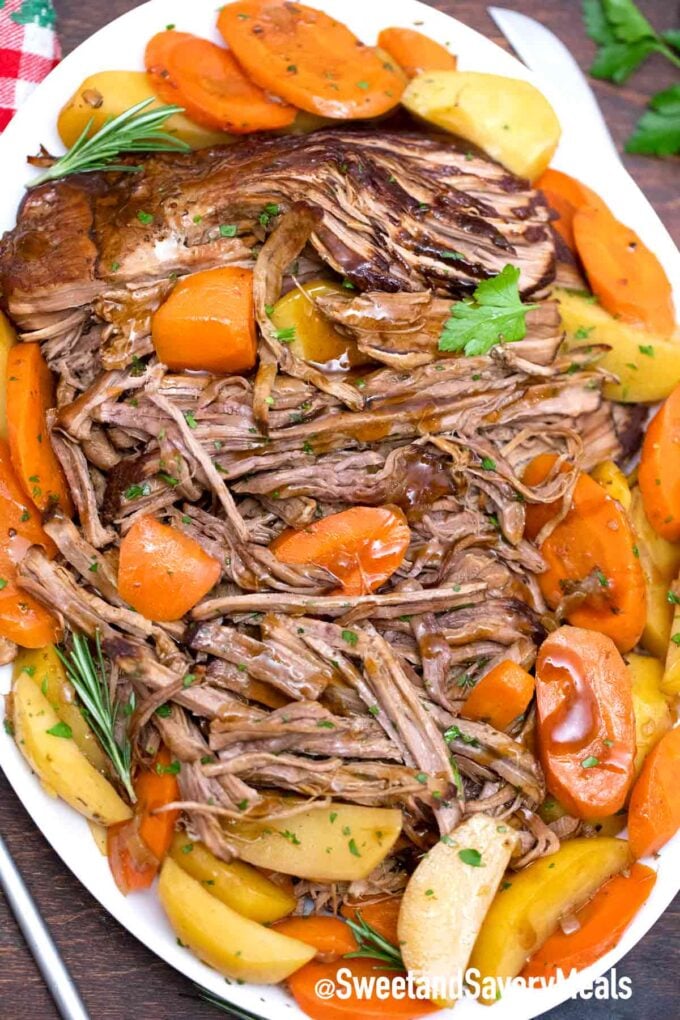
Frequently Asked Questions
It could be the balsamic vinegar. Be sure to get high-quality vinegar when making this recipe because it is the most important ingredient. If it does not taste right, it can turn the whole meal sour or bitter. Also, if the pan is not deglazed properly, the pieces will burn and cause a bitter taste in all the liquid. Too many bay leaves or burnt onions can also cause this. Adding a pinch of baking soda may help.
Remember to check the meat with a meat thermometer. I take mine out when it is 140 degrees F and let it rest in the pot for 20-30 minutes as it will continue to cook from the residual heat. However, some people cook their roast to 150 degrees F. I would not recommend cooking it that long because it would be too dry.
It could be that it was not cooked long enough. With balsamic glaze, it should be cooked for at least 15 minutes. But since it was mixed with a lot of other ingredients in this case, it may not be able to come to the same thickness as it would if it was being reduced by itself. Try simmering it for another 10 minutes. If that doesn’t work, add a teaspoon of cornstarch and heat it for another 10 minutes, which will do the trick.

Must-try pot roast recipes:
Loved this recipe? I’d love to hear from you! 💛 Leave a 5-star rating ⭐️ in the recipe card below and share your thoughts in the comments – I read and appreciate every single one!
Let’s stay connected! Follow me on Facebook, Instagram, Pinterest, and YouTube for more delicious, sweet and savory recipes. Have a question? Ask in the comments, and I’ll be happy to help! 😊 with love Catalina!

Balsamic Pot Roast
Ingredients
- 2 tablespoons canola oil
- 4 pounds boneless chuck roast
- 1 1/2 teaspoons kosher salt
- 1/2 teaspoon ground black pepper
- 1 yellow onion diced
- 4 cloves garlic minced
- 1 teaspoon fresh thyme finely chopped
- 1 teaspoon fresh rosemary finely chopped
- 1 teaspoon dried oregano
- 2 cups beef broth
- 2 tablespoons Worcestershire sauce
- 1/3 cup balsamic vinegar
- 2 tablespoons molasses
- 1/4 cup brown sugar
- 2 carrots chopped into 1 inch pieces
- 1 lb potatoes cut into 1 inch cubes
- 2 bay leaves
- 3 sprigs fresh rosemary
Instructions
- Pat dry the beef with paper towels and season it with salt and pepper.
- Place a large pot or Dutch oven over high heat and add two tablespoons of canola oil.
- Once the oil is hot, add the pot roast and brown on both sides for 3-5 minutes on each side or until nicely browned. Set aside.
- Add the diced onion to the pan and cook for 1-2 minutes. Add the garlic, thyme, rosemary, and oregano. Stir and cook for 1-2 minutes.
- Add 1 cup of the broth and scrape the bottom of the pan well.
- Add the rest of the broth, Worcestershire sauce, balsamic vinegar, molasses, and brown sugar. Stir to combine.
- Add the beef, carrots, and potatoes, and top with fresh rosemary and bay leaves.
- Preheat oven to 325 degrees F. Cover and cook in the oven for 3-4 hours or until fork-tender.
- Discard the bay leaves before serving.
- To make the sauce into a glaze, strain the liquid out after cooking, spoon off the fat, and discard it. Place the mixture in a small sauce pan and cook on medium heat until thickened, about 10-12 minutes.
- Garnish with fresh parsley and herbs when serving.
Video
Notes
Adding extra layers of flavor when deglazing
Deglazing is one of the most important steps in roasting. Browning the beef brings out the flavors in the roast and loosens the browned bits from the bottom of the pan. When deglazing the pan, I prefer beef broth to water because it gives the roast more flavor. However, other ways add even more flavor to the meat. I have used other ingredients for deglazing, like my favorite wine, such as Pinot Noir or Cabernet Sauvignon. Red wine vinegar would be an excellent choice, giving a sweet and tangy taste. Since this recipe uses balsamic vinegar, I like to keep the other flavors savory. For example, Worcestershire sauce or soy sauce would work with this sweet and tangy dish. I also like to use my favorite tomato sauce, made with San Marzano tomatoes combined with various herbs, to give it a multitude of flavors. Other things to try are apple cider, fruit juice, and beer.More tips to consider:
- I use a meat thermometer to check the temperature to be sure when it is done cooking.
- I like to serve my roast at 145 degrees F, so I remove it from the oven when it is 135 degrees F. It will continue to cook as it rests.
- Be sure to get high-quality vinegar to prevent bitterness and promote a good flavor.
- Heat the glaze for 15 to 20 minutes to thicken it. If that doesn’t work, I add cornstarch.
- Get a chuck roast or another cut of beef with a lot of collagen for a tender roast.
- Also, make sure to cook it low and slow for moist, juicy meat.

